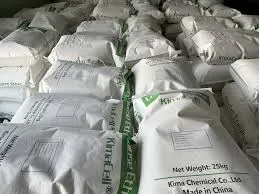
Sep . 03, 2024 17:13 Back to list
hpmc for detergent
The Role of HPMC in Detergents
Hydroxypropyl Methylcellulose (HPMC) has gained recognition in various industries, particularly in the formulation of detergents. This versatile polymer, derived from cellulose, exhibits unique properties that enhance the performance and stability of cleaning products, making it a preferred ingredient in modern formulations.
What is HPMC?
HPMC is a semi-synthetic derivative of cellulose, an abundant natural polymer. It is produced by the etherification of cellulose, which allows for the introduction of hydroxypropyl and methyl groups. These modifications lead to its solubility in water and ability to form gels, which are crucial for many applications, including detergents.
Benefits of HPMC in Detergents
1. Viscosity Control One of the primary roles of HPMC in detergent formulations is its ability to modify viscosity. Maintaining an optimal viscosity is essential for product stability, ensuring that the detergent flows easily from its container while remaining effective during use. HPMC can help achieve the desired thickness or thinness, accommodating both liquid and concentrated formulations.
2. Stabilization HPMC acts as a stabilizer in detergent formulations, aiding in the suspension of active ingredients and preventing separation. This ensures a homogenous product throughout its shelf life, which is crucial for consumer satisfaction and product performance.
hpmc for detergent

3. Film-Forming Properties When used in laundry detergents, HPMC can form a thin film on fabrics during washing. This film helps to ensure even distribution of cleaning agents, enhancing soil removal and providing a protective layer that can reduce re-soiling.
4. Improved Handling of Surfactants Surfactants are essential components of detergents responsible for removing dirt and grease. HPMC assists in optimizing the performance of surfactants, allowing them to work more effectively without the need for excessive quantities, which can be costly and may lead to environmental concerns.
5. Compatibility with Other Ingredients HPMC is compatible with a wide range of additives, such as enzymes, bleaches, and fragrance compounds. This versatility allows formulators to create complex, multifunctional detergents that meet diverse consumer needs.
Environmental Considerations
The growing awareness of environmental issues has led to increased scrutiny of detergent ingredients. HPMC is often favored because it is biodegradable and derived from renewable sources. This makes it an attractive alternative to synthetic polymers, which can have adverse environmental impacts. By incorporating HPMC into their formulations, manufacturers can appeal to eco-conscious consumers looking for sustainable cleaning solutions.
Conclusion
Hydroxypropyl Methylcellulose (HPMC) is a valuable ingredient in the formulation of detergents, offering multiple advantages that enhance product performance and consumer satisfaction. Its ability to control viscosity, stabilize formulations, and improve the efficacy of surfactants makes it indispensable in modern cleaning products. Additionally, its environmentally friendly profile aligns with the trend towards sustainable consumer goods, making HPMC a smart choice for manufacturers aiming to innovate while being mindful of their ecological footprint. As the demand for efficient and sustainable cleaning solutions continues to grow, HPMC is poised to play an increasingly significant role in the detergent industry.
-
Why HPMC is a Key Additive in Wall Putty Formulations
NewsAug.05,2025
-
Redispersible Powder in Decorative Renders: Function Meets Finish
NewsAug.05,2025
-
Redispersible Powder for Interior Wall Putty: Smooth Results Every Time
NewsAug.05,2025
-
HPMC’s Water Retention Capacity in Dry Mortar Applications
NewsAug.05,2025
-
HPMC Factory Contributions to Liquid Detergents
NewsAug.05,2025
-
How HPMC Factory Products Change Detergent Textures
NewsAug.05,2025







